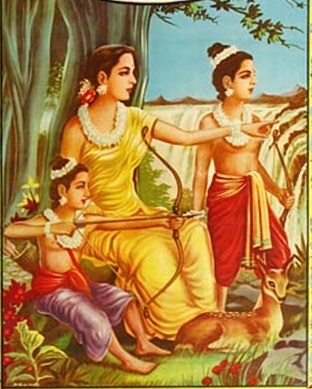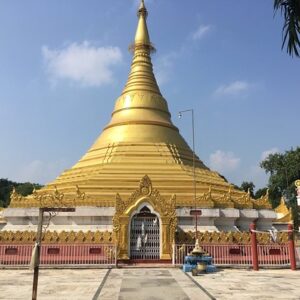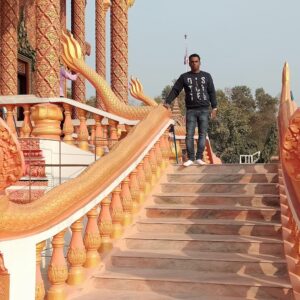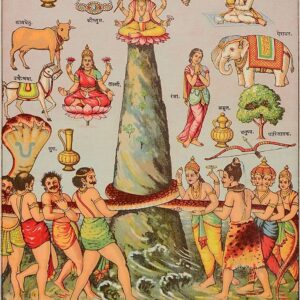Sita (Sanskrit: सीता; IAST: Sītā), also known as Siya, Janaki, Maithili, Vaidehi and Bhumija, is a Hindu goddess and the female protagonist of the Hindu epic, Ramayana. She is the consort of Rama, the avatar of the god Vishnu, and is regarded as a form of Vishnu’s consort, Lakshmi. She is also the chief goddess of Rama-centric Hindu traditions. Sita is known for her dedication, self-sacrifice, courage, and purity.
Described as the daughter of Bhūmi (the earth), Sita is brought up as the adopted daughter of King Janaka of Videha. Sita, in her youth, chooses Rama, the prince of Ayodhya as her husband in a swayamvara. After the swayamvara, she accompanies her husband to his kingdom, but later chooses to accompany her husband, along with her brother-in-law Lakshmana, in his exile. While in exile, the trio settles in the Dandaka forest from where she is abducted by Ravana, the Rakshasa king of Lanka. She is imprisoned in the garden of Ashoka Vatika, in Lanka, until she is rescued by Rama, who slays her captor. After the war, in some versions of the epic, Rama asks Sita to undergo Agni Pariksha (an ordeal of fire), by which she proves her chastity, before she is accepted by Rama, which for the first time makes his brother Lakshmana angry at him.
In some versions of the epic, Maya Sita, an illusion created by Agni, takes Sita’s place and is abducted by Ravana and suffers his captivity, while the real Sita hides in the fire. Some scriptures also mention her previous birth being Vedavati, a woman Ravana tries to molest. After proving her purity, Rama and Sita return to Ayodhya, where they are crowned as king and queen. One day, a man questions Sita’s fidelity and in order to prove her innocence and maintain his own and the kingdom’s dignity, Rama sends Sita into the forest near the sage Valmiki’s ashram. Years later, Sita returns to the womb of her mother, the Earth, for release from a cruel world and as a testimony of her purity, after she reunites her two sons Kusha and Lava with their father Rama.
Etymology and other names
The goddess is best known by the name “Sita”, derived from the Sanskrit word sīta, furrow.
According to Ramayana, Janaka found her while ploughing as a part of a yagna and adopted her. The word Sīta was a poetic term, which signified fertility and the many blessings coming from settled agriculture. The Sita of the Ramayana may have been named after a more ancient Vedic goddess Sita, who is mentioned once in the Rigveda as an earth goddess who blesses the land with good crops. In the Vedic period, she was one of the goddesses associated with fertility. Rigveda addressed to Agricultural Divinities, states
“Become inclined our way, well-portioned Furrow. We will extol you,
so that you will be well-portioned for us, so that you will be well-fruited for us.”
-Translated by Jamison and Brereton
In Harivamsa, Sita is invoked as one of the names of the goddess Arya:
O goddess, you are the altar’s center in the sacrifice,
The priest’s fee
Sita to those who hold the plough
And Earth to all living being.
The Kausik-sutra and the Paraskara-sutra associate her repeatedly as the wife of Parjanya (a god associated with rains) and Indra.
Sita is known by many epithets. She is called Jānaki as the daughter of Janaka and Maithili as the princess of Mithila. As the wife of Rama, she is called Ramā. Her father Janaka had earned the sobriquet Videha due to his ability to transcend body consciousness; Sita is therefore also known as Vaidehi.
Legend
Birth
The birthplace of Sita is disputed. The Sita Kund pilgrimage site which is located in present-day Sitamarhi district,Bihar, India is viewed as the birthplace of Sita. Apart from Sitamarhi, Janakpur, which is located in the present-day Province No. 2, Nepal, is also described as Sita’s birthplace.
Other versions
Janaka’s biological daughter: In Ramopkhyana of the Mahabharata and also in Paumachariya of Vimala Suri, Sita has been depicted as Janaka’s biological daughter. According to Rev. Fr. Camille Bulcke, this motif that Sita was the biological daughter of Janaka, as described in Ramopkhyana Mahabharata was based on the authentic version of Valmiki Ramayana. Later, the story of Sita miraculously appearing in a furrow was inserted in Valmiki Ramayana.
Ramayana Manjari: In Ramayana Manjari , North-western and Bengal recensions of Valmiki Ramayana, it has been described as on hearing a voice from the sky and then seeing Menaka, Janaka expresses his wish to obtain a child, and when he finds the child, he hears the same voice again telling him the infant is his Spiritual child, born of Menaka.
Reincarnation of Vedavati: Some versions of the Ramayana suggest that Sita was a reincarnation of Vedavati. Ravana tried to molest Vedavati and her chastity was sullied beyond Ravana’s redemption when she was performing penance to become the consort of Vishnu. Vedavati immolated herself on a pyre to escape Ravana’s lust, vowing to return in another age and be the cause of Ravana’s destruction. She was duly reborn as Sita.
Reincarnation of Manivati: According to Gunabhadra’s Uttara Purana of the ninth century CE, Ravana disturbs the asceticism of Manivati, daughter of Amitavega of Alkapuri, and she pledges to take revenge on Ravana. Manivati is later reborn as the daughter of Ravana and Mandodari. But astrologers predicted the ruin of Ravana because of this child. So, Ravana gives orders to kill the child. Manivati is placed in a casket and buried in the ground of Mithila, where she is discovered by some of the farmers of the kingdom. Then Janaka, king of that state, adopts her.
Ravana’s daughter: In Sanghadasa’s Jaina version of Ramayana, and also in Adbhuta Ramayana, Sita, entitled Vasudevahindi, is born as the daughter of Ravana. According to this version, astrologers predict that the first child of Vidyadhara Maya (Ravana’s wife) will destroy his lineage. Thus, Ravana abandons her and orders the infant to be buried in a distant land where she is later discovered and adopted by Janaka.














Reviews
There are no reviews yet